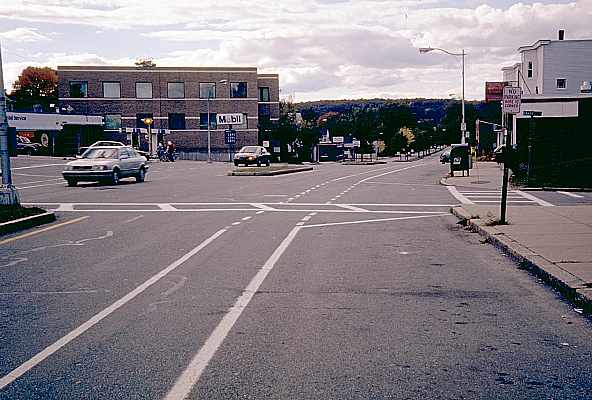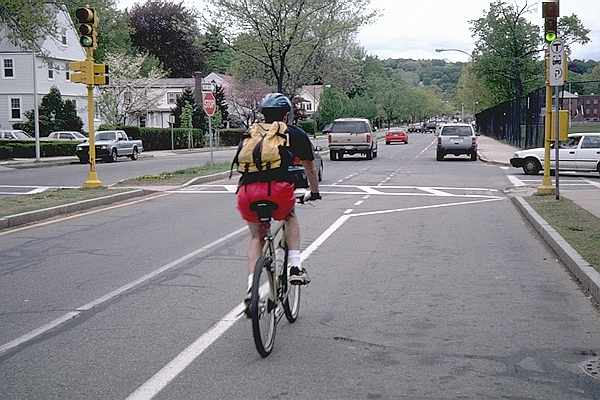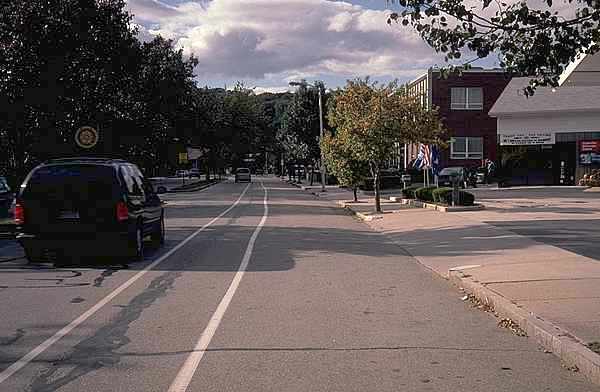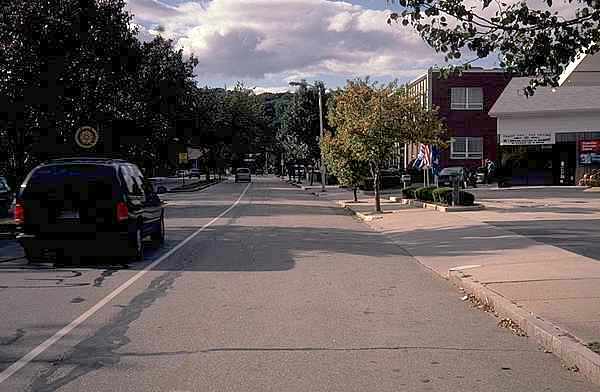
Top: Home Page
Up: Table of Contents
Previous:
Next:
CONCORD AVENUE BIKE LANES, BELMONT
|

Here's what Massachusetts traffic law (Ch. 90. section 14) says about right turns:
The right turning driver is required to merge to the right side of the roadway regardless of the existence of any special-purpose lanes such as a bike lane, parking lane or bus stop. Bike lanes confuse many people about how to make right turns -- including, apparently, the engineer who designed the Belmont lanes. There is a widespread public belief in "this is your lane, that is my lane, you stay over there and I stay over here and we'll get along." It doesn't work when a motorist or bicyclist must turn. In that case, it is often necessary to cross the path of other drivers. A merge before the intersection is safer than cutting across at the intersection. The street that enters from the right in the photo below is a one-way exit from Belmont High School. The area in the foreground is a transit bus stop. The striping here is the same as at the other intersections. When there are no parked cars or no bus in the bus stop, a bicyclist, such as the one in the photo, might prefer to ride to the right of the bike lane to allow comfortable spacing from motor vehicles. When a bus is stopped in the transit stop before the exit drive, a bicyclist must merge into the stream of motor traffic to maintain a safe clearance while overtaking the bus. In neither case is the bike lane the correct or safe place to ride. |

In the background of the photo above, a moving vehicle is overtaking a parked one. One of the goals of striping the bike lane appears to have been to narrow the travel lane and discourage motorists from speeding on this wide roadway. That goal places this bike lane farther than most from parked cars -- though also still partly in the "door zone", but too close to the moving stream of motor vehicles. Between the moving and parked vehicles, there is certainly not enough room for two bicyclists, one overtaking the other. Bicyclists need the 4 feet or more between their wheel tracks if they must overtake each other in the bike lane. But if the left side of the bike lane puts them too close to the overtaking traffic, they have to look back and merge into the traffic stream to overtake, whether or not there is a bike lane. The bike lane doesn't make looking back unnecessary, though it may give some bicyclists a false sense of security that they do not need to look back, and might convince other bicyclists to ride farther left even when there are no parked cars. In the photo above, the bicyclist is ignoring the bike lane stripe, making it easier for faster bicyclists to overtake. The Concord Avenue bike lane has no marking to indicate how to approach the entryway in front of the gas station in the photo below. If this bike lane were marked to indicate merges for all cross streets and driveways, it would be dashed for almost its entire length. |

For all the reasons I've given, I don't think a bike lane is an appropriate treatment for Concord Avenue. What would be appropriate? I have used computer graphics editing to alter the photo below. See what you think of it. |

| A single stripe like the one in the photo would narrow the travel lane, but would not
instruct bicyclists to ride close to the motor traffic or confuse motorists about how to
make right turns. But there is one remaining problem. Concord Avenue has parallel parking
over most of its length, but the parking stalls are not marked. If they were marked, then
it would be clear that the area to the right of the stripe is a parking lane, and
motorists would be discouraged from driving in it when the parking stalls are empty.
This treatment would not carry any confusing messages about how to make right turns, since
motorists are entirely used to merging into parking lanes, and parking stalls leave off before intersections.
After the striping of the bike lanes, the Town of Belmont retained a consultant who made suggestions for redesign. My comments on these suggestions follow. Next: response to consultant's suggestions. |